
In the collection, “Marys of the Sea,” Joanna C. Valente forces her readers to walk around with her amongst the debris of her body and mind in the wake of sexual violence. The violent, anatomy-heavy images embedded in this collection form a long string of lights that are nearly burnt-out. Valente tries to rekindle these lights individually through these poems, so that the timeline of her life is no longer muddled and the lights she has have been lit by herself. It is in this way that Valente rebrands herself as person and woman, not as victim.
The images in “Marys” are far from refreshing: they are gritty, sour, and raw depictions of the aftermath of sexual violence assessed as a tangible place—the woman’s body—and an intangible space—the grief and trauma that suspends itself in the brain like a bell jar. Valente shatters this jar through highly primitive imagery reflective of an assault victim’s loss of control: the body is a site of chaos in the title poem: “teeth gnash/skin—blood puddles stretch into slanted metal walls” (52). In the poem “Creation Myth” in which the speaker is asked by her perpetrator why she did not press charges, she writes “Self-control is difficult for humans:/our hearts still primitive. I scratch at skin/ until a new layer reveals/impermeable” (9). These are two examples of how Valente creates suffocating spaces for her images to bubble in their tension and alter our perception of sexual assault and trauma. There is an urgency to these images, demonstrating how violence continues to ruin the victim in the aftermath. In the first poem, “The Only Way Inside Is Through the Back Door,” Valente writes, “I can’t make it stop. A little blue bird is fluttering around inside/my brain, plucking out memories until my post-nasal drip/ is white noise” (3). The bodily processes and sensations being experienced are entirely out of the control of our narrator, building a sense of strangeness. Other images include the uterus viewed as a site of death (38), the womb a place for bees to swarm (19), and a pregnant belly compared to a hearse (37). These are Valente’s attempt to consume the feminine parts of her body by her own hand and reclaim control over them; mimicking the consumption of her own body and mind by abusers.
All of these poems tackle the issue of spaces, large and small, while interrogating gendered social roles like mother and wife. The collection opens with an excerpt from the Gospel of Mary, which emphasizes the irony of how often woman is lessened or ignored, when she is responsible for creating life on Earth. Framing this entire collection around a biblical myth is entirely deliberate. It is Valente’s attempt to reconsider the creation of earth and humankind—how it traces back to a woman. In the poem, “World Parent Myth,” this story is alluded to: “In the beginning, it started with/ a woman & a piece of fruit/ & a man who ate the fruit/ at the time it was a good idea” (39). But what is taken out of this story is not that life was created, and it was beautiful, but that the woman in this poem is ghosted and limited because of male action: “I was never able to wear/white the way/I wanted” because “violence/ is never far from the hands of men” (40).
The spaces occupied by these poems are highly muddled in the mind of the survivor, which goes hand in hand with the strangeness of body imagery that distances the victim from her own body and mind. In “Creation Myth,” Valente writes “I used to pray for a new body by moon/light, a return to being human” (10). She feels trapped in open spaces, and free in confined spaces like death. In a vehicle, the speaker wants to jump out—a small space is given up for death, which is viewed as an escape, a field of freedom for the victim rather than a dead-end (47). In her bedroom, Valente is overcome with immense and inescapable grief—which contradicts the idea of a room of one’s own as necessary and freeing; it also hammers in the permanent damage one lives with after such traumatic events (8). The spaces that are not muddled, but clarified, i.e. New York in “My Taste in Men Started Young,” are spaces consumed by violence: in New York that “she bled months worth of dead babies/ red icicles/ left in subways” (50). Not only is there an overwhelming desire to erase what happened, to create a new creation myth for herself and all women, there is an awareness throughout this collection that Valente is relentless in wanting to brand herself independent.
All of the poems in Joanna C. Valente’s collection have one thing in common: rewriting the creation myth to revere woman, and giving words to the experiences that freeze a woman’s mind, mouth, and heart shut. The anatomical language and sour, gritty images create an atmosphere blackened by the reverberation of trauma. In assessing domestic spaces and larger spaces like the universe, Valente places herself in between the two and feels out her purpose in the world post-sexual violence.
Reading this collection of poetry feels a lot like the phenomena of bruising—how once you are hurt, you are aware that the pain will continue beyond that moment, that there will be more dire consequences down the road. But you can never be prepared for the pain that comes ahead, when your skin actually unnaturally discolors and your body becomes foreign to you. This collection has given so much power and agency back to women, that it will be near impossible to ever consume a Mary of the Sea ever again.
Reviewed by: Juliet Wenzel
